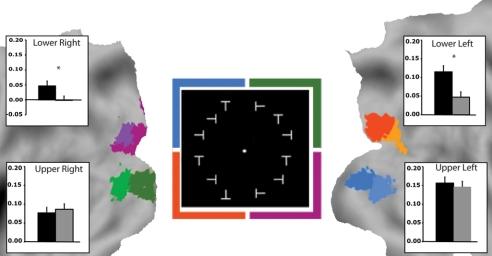Fig. 2.
Task-evoked modulation of the visual cortex after perceptual learning. (Center) Stimulus array with colored squares (not present in real display) indicating 4 visual quadrants. (Flat maps) visual cortex ROIs obtained from passive localizer scans by stimulating one quadrant at a time (Fig. S2). ROIs are projected onto a flattened representation of the posterior occipital cortex using the PALS (population-average, landmark, and surface-based) atlas (25). Bar plots: % signal change of BOLD in each quadrant when attending to the lower left quadrant and discriminating trained or untrained targets. Note that all 4 quadrants of the visual cortex were stimulated by the stimulus array, but only the trained visual quadrant in the right dorsal and the homologous area in left dorsal visual cortex show a shape-specific modulation. (Posthoc Newman-Keuls test, n = 12; Error bars, ± SEM; *, P < 0.05).

